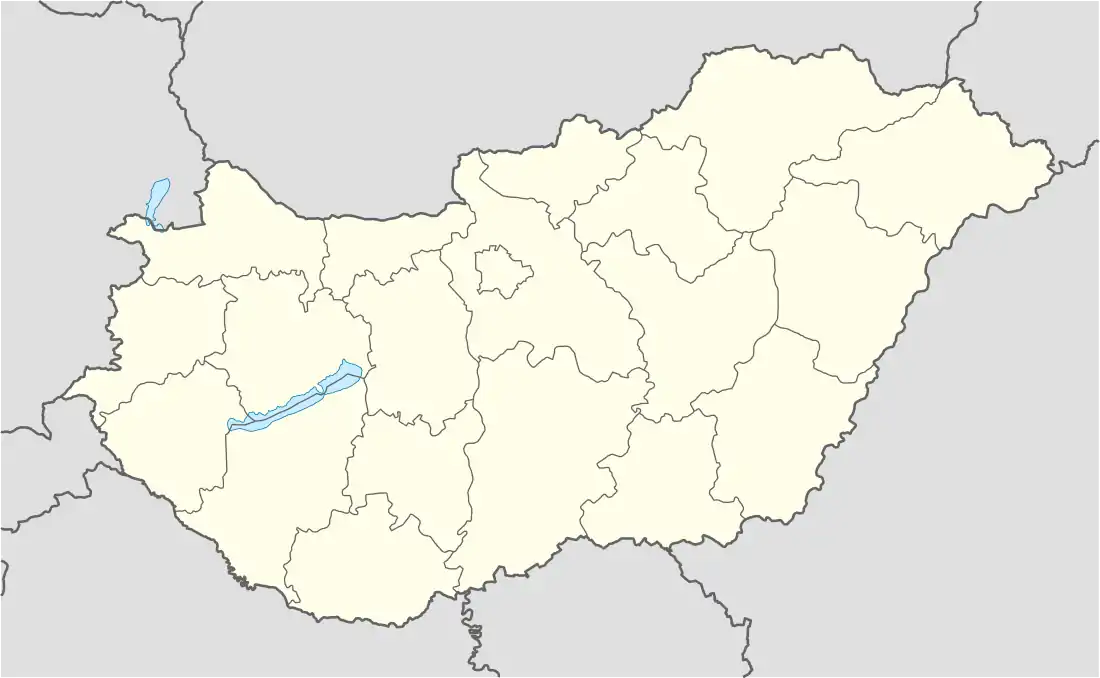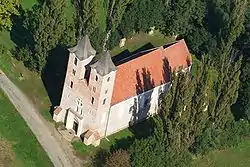Árpás | |
|---|---|
 Flag  Coat of arms | |
 Árpás Location of Árpás | |
| Coordinates: 47°30′48″N 17°23′29″E / 47.51331°N 17.39151°E | |
| Country | |
| County | Győr-Moson-Sopron |
| District | Tét |
| Area | |
| • Total | 14.27 km2 (5.51 sq mi) |
| Population (2017)[1] | |
| • Total | 261 |
| • Density | 18/km2 (47/sq mi) |
| Time zone | UTC+1 (CET) |
| • Summer (DST) | UTC+2 (CEST) |
| Postal code | 9132 |
| Area code | 96 |
| Website | http://www.arpas.hu/ |
Árpás is a village in Győr-Moson-Sopron County, Hungary, on the Little Hungarian Plain.
Etymology
Árpás means barley in Hungarian, a traditional product of the farms in the area; although today much more vegetables are grown, particularly cucumbers and tomatoes.[2]
Geography, history and landmarks

Árpás village is situated in the north-western part of Hungary, beside the river Rába, about 30 km from Győr. The bridge of Árpás is an important crossing point on the Rába. The village is built on a bench of the river with hills to the west. It is protected by a levee from the floods. Around the village there are backwater lakes, forests and fields. The municipality of Árpás consists of the village proper, the river section outside the levee, and the surrounding farms, on both sides of the Rába, with some as much as 5 km. away from the village centre.
The village is known for its Premonstratensian church (provostry) named Saint James. The provostry was founded in 1251 by Maurice II Pok. In 1300 Árpás was the property of Count Lőrinc Cseszneky. The convent was inhabited by Premonstratensian nuns from 1526 until 1577. And again, after the Turkish wars, Poor Clares from Nagyszombat resettled the convent. They rebuilt the church on the existing foundations with baroque style elements, finishing it in 1751.[3] Later this church became the parish church of the village.
The church is a beautiful example of the brick architecture from the Árpád age. One nave is built and closed with a simple apse, with two towers on the western side of the church, as it is the case in many churches in Hungary. From the original construction it has a Romanesque western doorway with tympanon.[4] The painting behind the main altar showed a Madonna with mantle, a rather popular iconographical topic painted around 1660.
In the early 19th century a lot of people emigrated overseas from Árpás.
References
- Ludwig E. (2002–2008): Rejtőzködő Magyarország. MN Online. A sorozat cikke Monoszló templomáról.
- Henszlmann, I. (1876): Magyarország ó-keresztyén, román és átmeneti stylü mű-emlékeinek rövid ismertetése, (Old-Christian, Romanesque and Transitional Style Architecture in Hungary). Királyi Magyar Egyetemi Nyomda, Budapest
- Genthon I. (1959): Magyarország műemlékei. (Architectural Heritage of Hungary). Budapest
- Szőnyi O. (É.n.): Régi magyar templomok. Alte Ungarische Kirchen. Anciennes églises Hongroises. Hungarian Churches of Yore. A Műemlékek Országos Bizottsága. Mirályi Magyar Egyetemi Nyomda, Budapest.
- Gerevich T. (1938): Magyarország románkori emlékei. (Die romanische Denkmäler Ungarns.) Egyetemi nyomda. Budapest
Notes and references
- ↑ "Árpás népessége" [Árpás population]. Népesség.com.
- ↑ "Járási Startmunka Mintaprogram 2017. március 1. és 2018. február 28. között" [District Start Work Sample Program between 1 March 2017 and 28 February 2018] (in Hungarian). Árpás Község Önkormányzata. 1 March 2017. Archived from the original on 3 July 2018.
- ↑ Béni, Alexandra (4 September 2017). "8+1 Must-See Churches in the Hungarian Countryside". Daily News Hungary. Archived from the original on 12 September 2017.
- ↑ A tympanon is a recessed, ornamental space formed by the cornices of a triangular pediment, or in this case between the arch and the lintel of the doorway.
External links
- Street map (in Hungarian)

